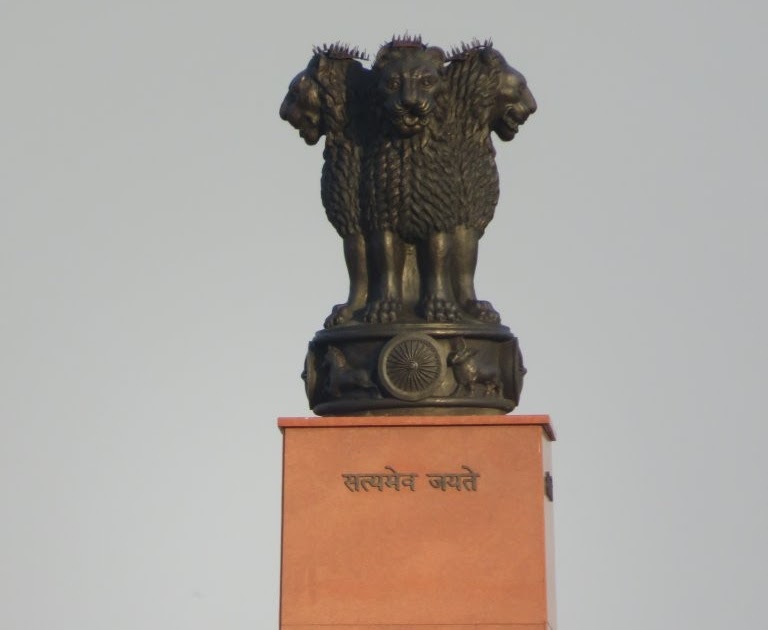Just a few steps from India Gate, in the heart of New Delhi, stands the National War Memorial, a solemn and dignified space dedicated to the soldiers of the Indian Armed Forces who laid down their lives in the line of duty after India gained independence.
Inaugurated in 2019, the memorial addresses a long-standing void. While India Gate commemorated soldiers of colonial-era wars, independent India’s fallen heroes now have a tribute befitting their sacrifice. This monument is not just a space for remembrance; it is a sacred circle of national gratitude and pride.
 |
| lose-Up of Ashoka Emblem at National War Memorial, Delhi |
A Long-Awaited Tribute
The India Gate, built in 1931, honours the memory of Indian soldiers who died during World War I and the Third Anglo-Afghan War. However, for decades, independent India lacked a national-level memorial for its own military martyrs.
After persistent demand from the armed forces and veterans, the National War Memorial was envisioned and constructed. It was inaugurated by Prime Minister Narendra Modi on 25 February 2019, marking a new chapter in how India remembers its war heroes.
Layout and Architectural Design
The memorial was designed by Yogesh Chandrahasan, and executed by the Central Public Works Department (CPWD). Its concentric layout is inspired by the concept of Chakravyuh, symbolizing layers of protection offered by the armed forces.
🔶 Key Zones of the Memorial:
-
Amar Chakra (Circle of Immortality)
-
The eternal flame (Amar Jawan Jyoti) burns continuously here.
-
At the centre, the Ashoka Chakra is inlaid on the ground in brass, representing the eternal values of dharma and righteousness.
-
-
Veerta Chakra (Circle of Bravery)
-
Showcases six bronze murals depicting legendary battles, including the Kargil War, the 1971 Bangladesh Liberation War, and Operation Meghdoot.
-
Celebrates valour and leadership.
-
-
Tyag Chakra (Circle of Sacrifice)
-
Features over 25,000 granite tablets, each inscribed with the name of a martyred soldier from the Army, Navy, and Air Force.
-
The muted design evokes a sense of reverence and reflection.
-
-
Rakshak Chakra (Circle of Protection)
Amar Jawan Jyoti – A Flame Relocated
The eternal flame that once burned under the arch of India Gate has now been respectfully relocated and merged with the flame at the National War Memorial. This symbolic act, done in January 2022, aligned the national tribute with the names of real heroes etched on the memorial walls, shifting the center of remembrance to a truly Indian context.
 |
| National War Memorial Pillar with Ashoka Emblem – New Delhi |
National Symbols: Ashoka Chakra and the Tricolour
-
At the heart of the Amar Chakra, the Ashoka Chakra—India’s national emblem of dharma—is embedded in the floor beneath the eternal flame.
-
A towering flag mast flies the Indian National Flag (Tiranga) high above the memorial grounds.
-
The flag remains illuminated after sunset, evoking quiet patriotism and honour.
-
Flags representing the Army, Navy, and Air Force are also displayed within the memorial, saluting the tri-services’ contributions.
Together, these symbols make the memorial not just a tribute to sacrifice, but a living expression of India’s constitutional and civilizational ideals.
A Sacred Space of Reflection
The National War Memorial is more than a military monument; it is a place where every citizen can connect with stories of courage and commitment. It also hosts annual events and ceremonies like:
-
Republic Day wreath-laying
-
Kargil Vijay Diwas observances
-
Visits by state dignitaries and military leaders
Visiting Information
-
📍 Location: Adjacent to India Gate, Kartavya Path, New Delhi
-
🕒 Timings: 9:00 AM – 8:00 PM (Closed on Mondays)
-
🎟️ Entry: Free and open to all
-
📷 Photography: Allowed (maintain decorum; this is a solemn site)
The National War Memorial near India Gate redefines how India remembers its heroes. With its thoughtful architecture, powerful symbolism, and heartfelt storytelling, it stands as a place of gratitude, national pride, and collective memory.
For anyone visiting Delhi—especially those interested in India’s military history and national values—this site is a must-see.
Happy travelling.
Related Articles:

